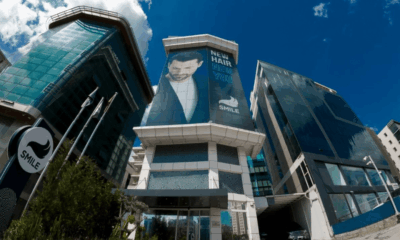Travel
Venice’s daytripper fee returns this week, rising to €10 for last-minute bookings
Venice’s daytripper tax is relaunching this week, and the fee has doubled to €10 for last-minute visitors.
Mayor Luigi Brugnaro stressed that the tax aims to help the city and its citizens battle overtourism and avoid huge influxes of visitors during crowded holidays and weekends.
The payment system was launched last year for a time-limited pilot program.
Venice introduced the long-discussed daytripper fee after the city narrowly escaped being placed on the UN’s list of endangered heritage sites, due largely to the impact of overtourism.
Visitors staying overnight in the historic centre are exempt from the charge as they already pay a tourist tax.
How does Venice’s entry fee work?
The new tax will be applied every Friday through Sunday and on holidays from 18 April to 27 July, for a total of 54 days.
That’s almost double the number of days it was in place last year. Tourists who don’t make reservations up to four days in advance will pay €10 instead of the usual €5.
The tax will be in force during peak hours, from 8.30 am to 4 pm.
Anyone found beyond designated control points without the required documentation will be subject to fines.
These will range from €50 to €300, plus the maximum entrance fee allowed by law, set at €10.
Officials have emphasised that the programme aims to reduce crowds on peak days, encourage longer visits and improve the quality of life for residents.
The fee is not required for anyone staying in Venice, including the mainland districts of Marghera and Mestre. Venice’s islands, including glass-making Murano, are also outside the program.
Exemptions are also issued for a variety of reasons, including to access the city for work, school or medical care, as well as to people born in Venice and residents of the Veneto region.
How can I book my ticket for Venice?
Visitors can ‘reserve’ their day in Venice on a dedicated platform.
Daytrippers pay the required fee (€5 or €10) and get a QR code that will then be checked at spot controls at seven access points around the city, including at the main train station.
Visitors with hotel reservations enter their hotel information and also get a QR code to show. They don’t have to pay, however, since their hotel bill will already include a Venice lodging fee.
Why has Venice introduced an entry fee?
Venice has long suffered under the pressure of overtourism, but officials say pre-pandemic estimates ranging from 25 to 30 million visitors a year – including daytrippers – are not reliable and that the pilot project also aimed to come up with more exact figures to help better manage the phenomenon.
By contrast, registered visitors spending the night last year numbered 4.6 million, according to city figures, down 16 per cent from pre-pandemic highs.
The pandemic delayed Venice’s plans to launch the daytripper tax, which has become a keystone of the city’s attempts to deal with overtourism.
UNESCO cited the plan when it decided not to include the city on the list of endangered world heritage sites last September, a tarnish that it similarly avoided two years earlier with the cruise ship ban through St. Mark’s Basin and the Giudecca Canal.
Cruise ships brought 1.6 million people to Venice in 2019.
Activists sounded a warning last summer when the number of tourist beds officially overtook the number of residents, which has dwindled to under 50,000 in a trend dating back decades.
They said the imbalance drains the city of services, clogging its tight alleyways and water buses with suitcase-toting tourists and pushing residents to the mainland with its conveniences.
Was the trial of the entry fee a success?
At the end of the first test phase last July, officials said the tax had netted €2.4 million, accounting for about 1,000 entrances on each of the test days.
Brugnaro responded to critics who have called it a failure and said it did not deter as many arrivals as expected.
“Venice is the first city in the world that tries to manage the problem of overtourism. We obtained important results,” the mayor said.
But some citizens’ groups and opposition councillors claim the access fee completely failed to control overtourism.
“Data offered by the control room show that on average during the period of implementation of the fee, we had about 7,000 more tourist entries than in previous years,” said Giovanni Andrea Martini, an opposition councillor.
“This shows that the access fee is not at all a system able to manage the flows.”
Travel
Norway to introduce tourist tax amid record visitor numbers and overtourism concerns
By Euronews Travel
Published on
ADVERTISEMENT
Norway is set to become the latest European destination to introduce a tourist tax to combat concerns about rising visitor numbers.
Lawmakers approved the new levy on Thursday, which allows municipalities to introduce a 3 per cent tax on overnight stays in “areas particularly affected by tourism”.
The law allows local authorities to apply the tax at their own discretion, and it will be added to accommodation charges. Authorities will also be allowed to adjust the percentage based on the season.
The funds raised by the tax will be used exclusively to improve tourism infrastructure projects that benefit both visitors and local people. Municipalities will have to demonstrate that their facilities are inadequate and have their plans approved by the government to spend the funds.
Cecilie Myrseth, Norway’s minister of trade and industry, said on social media that her government had reached a “historic agreement” to introduce a tourism tax that was “in line with what they have in the rest of Europe”.
The country is the latest in a string of European nations introducing or increasing visitor levies to tackle the growing problem of overtourism. A tax may also be applied to cruise ships that make stops in the country, particularly in areas that are most affected by overtourism.
Norway is experiencing a tourism boom
As tourists increasingly choose cooler, northern European destinations to get away from the heat, Norway has experienced a boom in visitor numbers.
Last year, a record-breaking 38.6 million people booked accommodation in the country. That includes more than 12 million overnight stays by foreign tourists – a 4.2 per cent increase from 2023.
Some previously quiet destinations have been overwhelmed, like the Lofoten islands, where eye-catching images of hiking trails posted on social media have led to an influx of visitors. With a population of 24,500 people distributed across several small towns and villages, keeping up with the cost of all these new visitors has been hard.
A recent survey by industry organisation Norwegian Tourism Partners found that 77 per cent of people in Tromsø, in northern Norway above the Arctic Circle, thought there were too many tourists there. Visitors have been drawn by the Northern Lights, wildlife excursions, Sami cultural experiences and what the city itself has to offer.
The increase in tourism has caused tension with local residents across Norway as infrastructure has struggled to keep up with the boom. Facilities like public toilets and car parks have been overwhelmed in popular destinations.
Some residents have even reported cases of people using their back gardens as toilets, and bemoaned the increased traffic clogging up Norway’s roads.
Travel
Wildfire warnings issued in the Canary Islands as millions prepare to holiday there
ADVERTISEMENT
As millions of holidaymakers prepare to head to the Canary Islands this summer, authorities have issued a wildfire pre-alert across the archipelago.
The warning, announced by the General Directorate of Emergencies on Sunday, applies to tourist hotspots El Hierro, La Palma, La Gomera, Tenerife and Gran Canaria.
It comes as the islands enter a high-risk fire period following the wet season, as hot, dry winds known as the ‘calima’ begin blowing in from the Sahara Desert.
Fires are common, but they haven’t slowed tourism
The risk of wildfire is nothing new for the Canary Islands.
The volcanic terrain, Mediterranean climate and fire-adapted vegetation – plants that have evolved to thrive in fire-prone environments – make them susceptible to summer blazes, and scientists say wildfires are part of the archipelago’s ecological rhythm.
Some of the worst occurred in 2023, when forest fires ravaged Tenerife, destroying more than 15,000 hectares of land and forcing 12,000 people to evacuate. The blaze was later found to have been started by arsonists.
This year, officials are urging tourists and locals alike to take extreme caution, warning against launching fireworks near forests and discarding cigarettes on dry ground.
But even as the fire warnings roll in, the Canaries’ appeal shows no signs of slowing down.
In 2024, the islands welcomed nearly 18 million tourists, including a record-breaking 15.5 million international arrivals. Among them, British travellers led the way, recording 6.3 million visits – up 500,000 from 2023.
Concerns about overtourism mount amid record arrivals
While the Canary Islands continue to attract record numbers of tourists, residents are increasingly voicing concerns about overtourism.
In April 2024, tens of thousands of islanders participated in protests, holding signs that read “the Canary Islands have a limit” while rallying against rising housing costs, environmental damage and the strain on public services.
Over Easter this year, about 80,000 hospitality workers in Tenerife, La Palma, La Gomera and El Hierrowalked out in a dispute with unions over pay.
The surge in short-term rentals has been especially contentious. Locals have reported getting priced out of their neighbourhoods as properties are converted into holiday lets, the cost of living soars and wages stagnate.
Despite these concerns, tourism remains a significant part of the Canary Islands’ economy, accounting for approximately 35 per cent of its GDP.
Tenerife still reigns supreme
After welcoming seven million tourists in 2024, Tenerife remains the most visited island.
Its year-round sunshine and wide beaches keep it a firm favourite among families, especially during the UK’s summer school break and throughout the winter months.
As the peak summer season picks up, local tourism boards have made no indication that the fire pre-alerts will disrupt travel plans.
But authorities remain focused on prevention this year.
More than 2,000 firefighters are on standby. Meanwhile, the government has distributed detailed safety advice, urging people to prepare a go-bag, stay informed and follow emergency evacuation or shelter-in-place instructions if fires erupt.
Travel
Violent turbulence hits Ryanair flight in Germany, forcing an emergency landing and injuring 9
By Euronews Travel with AP
Published on
ADVERTISEMENT
Severe storms in southern Germany forced a Ryanair flight to make an emergency landing late Wednesday after violent turbulence injured nine people on board, German police said in a statement Thursday.
The flight, travelling from Berlin to Milan with 179 passengers and six crew members, encountered turbulence so intense around 8:30 pm that the pilot was forced to make an unscheduled landing at Memmingen Airport in Bavaria.
Eight passengers and one crew member were hurt.
Three people were taken to the hospital in Memmingen for treatment; the other injured people were released after receiving outpatient treatment. As a precaution, all passengers were checked for injuries by the emergency services.
Authorities did not permit the plane to continue flying, and the airline arranged bus transport for passengers. Milan is about 380 kilometres south of Memmingen.
More bad weather expected in Germany
Elsewhere in the region, storms damaged several homes in Ulm, Baden-Württmberg, according to the German news agency dpa.
In the Donaustetten district, strong winds tore roofs off multiple row houses, rendering them uninhabitable, though no injuries were reported. Fire officials suspect a small tornado or waterspout caused the damage. The German Weather Service (DWD) is investigating, according to dpa.
Storm-related emergency calls also came from other areas in southern Germany, where damage was mostly limited to fallen trees and flooded basements.
The DWD warned of further storms on Thursday, 5 June, with hail, strong winds, and localised heavy rain expected.
-

 Politics7 days ago
Politics7 days agoEU Launches Landmark €150 Billion Defence Initiative to Bolster Security and Deterrence
-

 Politics7 days ago
Politics7 days agoEU Turns Its Gaze on the Porn Giants: Brussels Launches Landmark Investigation to Shield Minors Online
-

 Politics7 days ago
Politics7 days agoEyes in the Sky: Europe Doubles Down on Satellite Data to Safeguard the Future
-

 EU & the World6 days ago
EU & the World6 days agoSmile Hair Clinic in Turkey: A Leading Destination for Hair Transplant Procedures
-

 Sports6 days ago
Sports6 days agoSimone Inzaghi, his wife’s confession on Instagram
-

 EU & the World6 days ago
EU & the World6 days agoTom Thibodeau’s Net Worth: How Much Money the Ex-Knicks Coach Has
-

 Politics6 days ago
Politics6 days agoNature, climate, and circular economy projects emerge as winners at the 2025 LIFE Awards
-

 Sports4 days ago
Sports4 days agoMarc Marquez wants to make no more mistakes and heralds news









